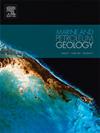苏北盆地古近系阜宁组页岩孔隙结构及微观流体赋存特征
IF 3.7
2区 地球科学
Q1 GEOSCIENCES, MULTIDISCIPLINARY
引用次数: 0
摘要
微观孔隙结构和矿物组成对页岩流体的分布和赋存起着至关重要的控制作用。以苏北盆地高邮凹陷古近系阜宁组页岩为研究对象,采用核磁共振(NMR) T2、T1-T2测试、岩石分析、扫描电镜(SEM)和低温氮吸附/解吸(LTNA/D)等综合分析方法对样品进行了研究。重点研究有机质、矿物组成和孔隙结构对流体赋存分布的影响。结果表明,孔隙类型以石英和方解石中的粒间孔和粒边孔为主,黏土矿物伴生的粒内孔次之。核磁共振T2谱以p2 (1 - 30 ms)和p1 (<1 ms)峰为主,分别对应中孔(100 - 1000 nm)、微孔和微孔(<100 nm)。核磁共振T1-T2技术有效地量化了接收状态(AR)和水油恢复状态(WOR)下孔隙流体的分布和含量。原始孔隙油的损失主要是由于可动油的运移造成的。页岩中有机质丰度影响其含油量,有机质富集过多往往会限制页岩油的流动性。孔隙流体的分布主要由孔隙结构决定。毛细管结合水和吸附油主要发生在微孔和微孔中,而孔隙水的存在进一步影响了吸附油的空间分布。相反,毛细管结合油主要集中在中孔中,而可动油主要储存在大孔(1000 nm)中。不同岩性的矿物含量对页岩油水分布有显著影响。富含粘土的页岩通常含有较多的毛细管结合水。石英-泥质混合(FAM)页岩表明,石英含量的增加进一步增强了页岩油的赋存和流动性,而方解石含量的增加则起到相反的作用。相反,在以方解石为主的泥质-钙质混合(ACM)页岩中,方解石含量越高,游离油的聚集量越大。这些发现对研究苏北盆地高邮凹陷页岩油富集机理具有重要意义,对页岩油甜点识别具有实际指导意义。本文章由计算机程序翻译,如有差异,请以英文原文为准。
Insights into shale pore structure and microscopic fluid occurrence characteristics in the Paleogene Funing Formation, Subei Basin, China
Microscopic pore structure and mineral composition play a critical role in controlling the distribution and occurrence of shale fluids. This study examines shale samples from the Paleogene Funing Formation in the Gaoyou Sag of the Subei Basin using an integrated approach, including nuclear magnetic resonance (NMR) T2 and T1–T2 tests, Rock-Eval, scanning electron microscopy (SEM), and low-temperature nitrogen adsorption/desorption (LTNA/D) analyses. This study focuses on the influence of organic matter, mineral composition, and pore structure on the occurrence and distribution of fluids. Results indicate that the pore types primarily consist of intergranular and grain-edge pores amidst quartz and calcite, with secondary contributions from intragranular pores associated with clay minerals. The NMR T2 spectra are dominated by p2 (1–30 ms) and p1 (<1 ms) peaks, corresponding to mesopores (100–1000 nm), micro- and minipores (<100 nm), respectively. The NMR T1–T2 technique effectively quantifies pore fluid distributions and contents in both the as-received (AR) and water-oil restoration (WOR) states. The loss of original pore oil is mainly due to the migration of movable oil. The abundance of organic matter in shale affects its oil content, with excessive organic matter accumulation tending to restrict shale oil mobility. Pore fluid distribution is predominantly determined by pore structure. Capillary-bound water and adsorbed oil primarily occur in micro- and minipores, while the presence of pore water further influences the spatial distribution of adsorbed oil. Conversely, capillary-bound oil is primarily concentrated in mesopores, whereas movable oil is mostly stored in macropores (>1000 nm). Mineral contents in different lithologies exert a significant influence on the distribution of shale oil and water contents. Clay-rich shale typically exhibits higher amounts of capillary-bound water. Felsic-argillaceous mixed (FAM) shales, show that an increase in quartz content further enhances the occurrence and mobility of shale oil, while higher calcite content has the opposite effect. Conversely, in argillaceous-calcareous mixed (ACM) shales, which are dominated by calcite, higher calcite content is associated with larger accumulations of free oil. These findings may provide valuable insights into the mechanisms of shale oil enrichment and offer practical guidance for identifying sweet spots in the Gaoyou Sag, Subei Basin.
求助全文
通过发布文献求助,成功后即可免费获取论文全文。
去求助
来源期刊

Marine and Petroleum Geology
地学-地球科学综合
CiteScore
8.80
自引率
14.30%
发文量
475
审稿时长
63 days
期刊介绍:
Marine and Petroleum Geology is the pre-eminent international forum for the exchange of multidisciplinary concepts, interpretations and techniques for all concerned with marine and petroleum geology in industry, government and academia. Rapid bimonthly publication allows early communications of papers or short communications to the geoscience community.
Marine and Petroleum Geology is essential reading for geologists, geophysicists and explorationists in industry, government and academia working in the following areas: marine geology; basin analysis and evaluation; organic geochemistry; reserve/resource estimation; seismic stratigraphy; thermal models of basic evolution; sedimentary geology; continental margins; geophysical interpretation; structural geology/tectonics; formation evaluation techniques; well logging.
 求助内容:
求助内容: 应助结果提醒方式:
应助结果提醒方式:


